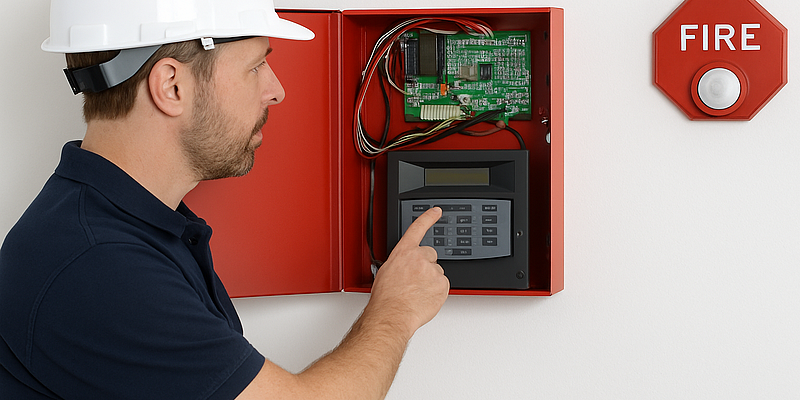-
24 Hour Emergency Service
- 24 Hour Emergency Service
8 Mistakes Every Electrician Makes When Installing Fire Alarm Systems (and How to Avoid Them)
Introduction
I’ve been installing, designing, and servicing fire alarm systems for over 25 years in one of the toughest cities in the world: New York City. From schools and train stations to detention centers and hospitals, I’ve seen it all and I’ve seen just about every mistake electricians make when installing fire alarm systems.
Some are small oversights that delay inspections, while others can literally put lives at risk. In this post, I’ll break down the eight most common fire alarm installation mistakes I see in the field and how you can avoid them to stay compliant, efficient, and professional.
1. Ignoring Filing and Permit Requirements
Most contractors rush into projects focused on timelines walls going up, finishes going in but fire alarm filing requirements can take 10 to 12 weeks before you’re even cleared to pull wire.
You need licensed engineering drawings, AutoCAD layouts, and FDNY approvals before installation begins. Failing to plan for this delay leads to chaos on-site and costly rescheduling later. Always start the filing process early and educate your general contractors about the real timeline.
2. Using the Wrong Fire Alarm Cable
This one happens constantly. The National Electrical Code (NEC Article 760) requires power-limited fire alarm cables rated at 300 volts. You must use the correct cable gauge typically #16 for data and #14 for power.
Mixing cable types or using cheaper, unmarked wire may save a few bucks upfront, but it can destroy control boards, fail inspections, or void warranties. Always use the manufacturer-specified cable and charge accordingly doing it right pays for itself.
3. Poor Wiring Practices
Bad wiring is one of my biggest pet peeves. Too many electricians still wire systems in series when they should be in parallel. Junction boxes turn into star topologies, wires cross over circuits, and suddenly your data loops short out.
Use separate runs for each system function data, horn/strobes, and power and plan your junction boxes to accommodate proper ins and outs. A clean wiring layout isn’t just professional; it’s the foundation of a reliable system.
4. Incorrect Device Spacing and Mounting
Smoke detectors and horn strobes must be installed exactly where they appear on approved plans. Obstacles like ductwork, lights, or sprinklers aren’t an excuse for bad placement.
Remember key mounting standards:
- Pull stations: 48–54 inches AFF (Above Finished Floor)
- Horn/Strobes: 80–96 inches AFF to the lens
- Smoke detectors: Centered, evenly spaced, and away from corners or obstructions
- Correct placement ensures optimal coverage and compliance with NFPA 72 standards.
5. Skipping Functional Testing
Testing every device and verifying communication to the control panel and central station is non-negotiable.
Too often, electricians assume relays or waterflows “should work” and leave them unverified. When the FDNY inspector shows up and finds issues, it’s embarrassing and expensive.
Test everything early, document it with photos or video, and walk into your inspection with confidence knowing every input and output works as designed.
6. Messy Panel Terminations
A clean fire alarm panel tells you everything you need to know about the installer.
Dress your wires neatly, maintain 90-degree angles, and secure cables with tie wraps. Strip only what you need no exposed copper, no ground faults. Take pride in your work. When someone opens that panel later, they should instantly know a professional did the job.
7. Missing As-Built Drawings
Changes happen during installation device relocations, field adjustments, wiring reroutes. But failing to update and submit as-built drawings is one of the biggest causes of inspection delays.
Before final inspection, you must provide:
- A stamped as-built riser diagram
- Updated device layout drawings
- A framed copy posted at the fire alarm control panel
- This documentation proves your system matches the approved design and is ready for turnover.
8. Working Without a License
This is the worst offense, and it happens more than it should.
Fire alarm systems are life safety systems, not weekend wiring projects. If you’re unlicensed and touch a smoke detector or panel, you’re exposing yourself to $10,000–$15,000 in fines and serious liability.
Always hire or subcontract a licensed fire alarm professional. It’s safer for everyone and keeps your reputation intact.
Final Thoughts
Every mistake on this list costs time, money, or credibility and some could cost lives. If you’re serious about mastering the craft and doing things the right way, invest in your education and training.
Join the Fire Alarm Business Blueprint a complete program that helps you go from technician to CEO, learn how to get licensed, design systems, and grow your business the right way.
And if you want to learn how to read fire alarm drawings like a pro, check out the next video on my channel and subscribe so you never miss a training update.
‹ Back













Comments